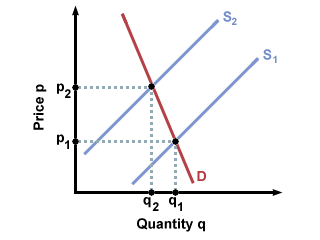The Substitution Effect
We've seen how elasticity can affect changes in price and quantity in a market economy on a graph, but does this actually happen in the real world? While it is unlikely that demand for very many goods is perfectly elastic or perfectly inelastic, economists recognize that demand for certain goods will be more elastic than others, and demand for certain goods will be less elastic. So, while the extreme cases are pretty rare, elasticity still has some effect over market behavior.
Goods with very elastic demand tend to be non-necessary goods, or goods that cane be easily substituted for by other goods. When the prices of these goods go up, consumers will either decide they don't really need the goods, and won't buy any, or they will begin to substitute away from the goods, buying more of the cheaper substitutes. One possible example of a non-essential good might be candy. It is not an essential good, and if the price were to double, demand would probably fall a good deal as consumers decide they don't really need to eat candy, especially since it costs so much money. An easily substituted good might be cola. If the price of one brand of cola increases, demand will drop quickly as consumers decide to buy a competing brand, whose price has stayed the same.
Goods with very inelastic demand tend to be goods with no easy substitutes, or essential goods that consumers cannot do without. For these goods, even when the price increases, demand stays relatively steady, because consumers have no other options, and feel that they still need to buy the same amount of goods. In the short run, gasoline could be considered an inelastic good, since it is difficult to completely alter transportation patterns in an immediate response to changes in gasoline prices. (Over the long run, however, consumers may change their habits and decrease their consumption of gasoline, using public transportation or carpools, once they realize that their costs have increased permanently). Another example might be staple foods. While luxury items such as caviar or Belgian chocolates aren't essential to our diet, basics such as bread, pasta, and rice are relatively indispensable. In other words, an increase in price would have less affect on the consumption of staple foods than it would have on luxury foods.
Shifting Supply or Demand Curves
Another way in which elasticity takes on practical meaning is through the impact
of shifting supply or demand curves. Shifts in one curve can have drastically
different effects, depending on how elastic or inelastic the other curve is.
For instance, let's take another look at the market for gasoline. Because
demand is relatively inelastic, at least in the short run, when OPEC decides to
tighten up supply and send less oil to the U.S., the inward shift in the supply
curve causes much higher prices, with a slight drop in quantity consumed.

Practically speaking, the government often has to take such effects into consideration before making policy changes. For example, if the government's goal is to limit imports in order to promote domestic industry, it must first consider whether its policy will have the desired effect. If demand for imports is inelastic, an increased tariff on imports will only result in increased prices without a significant drop in quantity of imports consumed, which does not benefit domestic producers and only results in angry domestic consumers.













